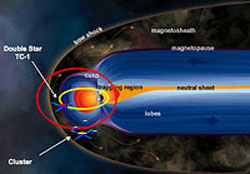Details of solar particles penetrating the Earth’s environment revealed

Cluster and Double Star orbits on 8 May 2004
On 8 May 2004, one of the two Double Star satellites (TC-1) and all four Cluster spacecraft found themselves in the firing line. For about 6 hours, the Cluster spacecraft were buffeted every 8 minutes by intense flows of electrically charged particles released by the Sun. The Double Star TC-1 spacecraft had it even rougher, being blasted every four minutes for eight hours.
During such events, magnetic channels created by the merging of the Sun and the Earth’s magnetic fields allow solar particles to break through the Earth’s magnetic shield and penetrate the Earth’s environment. Physicists call the occurrence of these magnetic channels Flux Transfer Events. Each magnetic channel appears like a curve shaped tube that can be anything from 5000 to 25000 kilometres in diameter. One end of the magnetic flux tube is connected to Earth while the other end is connected to the solar wind.
The basic physical mechanism responsible for the occurrence of flux transfer events is called magnetic reconnection. In the 1950s, space physicists believed that magnetic reconnection let solar particles break through at a steady rate. That view changed in the late 1970s, when several studies showed that the magnetic reconnection could also be intermittent and take place in pulses, lasting a few minutes. Each pulse produces a magnetic flux tube (a Flux Transfer Event).
On 8 May 2004, these magnetic flux tubes swept over Cluster and Double Star again and again. As the Cluster and Double Star data clearly showed, the same location underwent magnetic reconnection several times, creating new successive magnetic flux tubes to channel more charged particles towards the Earth. The observations stopped probably because the spacecraft moved out of range and not because the reconnection region weakened in any way.
The data from the five spacecraft allowed scientists led by Aurélie Marchaudon of the Laboratoire de Physique et Chimie de l’Environnement, Centre Nationale de la Recherche Scientifique (CNRS) and Université d’Orléans, Orléans, France to triangulate the location of the magnetic reconnection region, and to deduce its size. They found that the reconnection site was located on the daylight west side of the Earth’s magnetic shield and was around 25000 kilometres across. A computer simulation of the event, conducted by Jean Berchem of the University of California Los Angeles (UCLA) and his team, confirmed the possibility of magnetic reconnection occurring at that location.
Although intermittent reconnection has been observed in the past, this was one of the longest series of continuous observations ever taken of a magnetic reconnection region in the Earth’s magnetosphere. Perhaps most surprising is that 8 May 2004 was just relatively a normal day for the Earth’s magnetic field. There were no large magnetic storms on Earth, or spectacular aurorae to fill the night sky. However, Cluster and Double Star revealed that energetic particles from the Sun were blasting their way through the Earth’s magnetic shield and penetrating the Earth’s environment.
Each day, Cluster and Double Star return more observations that allow scientist to understand the invisible magnetic turbulence high above our heads.
Media Contact
More Information:
http://www.esa.int/esaSC/SEM5ZTKKKSE_index_0.htmlAll latest news from the category: Physics and Astronomy
This area deals with the fundamental laws and building blocks of nature and how they interact, the properties and the behavior of matter, and research into space and time and their structures.
innovations-report provides in-depth reports and articles on subjects such as astrophysics, laser technologies, nuclear, quantum, particle and solid-state physics, nanotechnologies, planetary research and findings (Mars, Venus) and developments related to the Hubble Telescope.
Newest articles

Superradiant atoms could push the boundaries of how precisely time can be measured
Superradiant atoms can help us measure time more precisely than ever. In a new study, researchers from the University of Copenhagen present a new method for measuring the time interval,…

Ion thermoelectric conversion devices for near room temperature
The electrode sheet of the thermoelectric device consists of ionic hydrogel, which is sandwiched between the electrodes to form, and the Prussian blue on the electrode undergoes a redox reaction…

Zap Energy achieves 37-million-degree temperatures in a compact device
New publication reports record electron temperatures for a small-scale, sheared-flow-stabilized Z-pinch fusion device. In the nine decades since humans first produced fusion reactions, only a few fusion technologies have demonstrated…





















